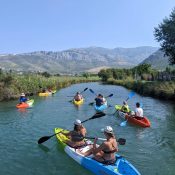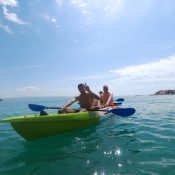7-Type of Flatwater Kayaks

7-Type of Flatwater Kayaks
7-Type of Flatwater Kayaks
How deep does the rabbit hole go in the kayak world?
The last time we just scratched the surface and briefly talked about the cold history of kayaking – and if you remember, we covered our strongest jawline biter and family yacht builder.
In today’s blog post, it’s time to hone in. It’s time to help you discover the best type of kayak for you, and it’s time to show you how deep the rabbit hole goes in the kayak world.
I hope you have your favorite cup of drink because we are ready to start.
Are you a white or flat kayak fan?
I almost sound racist here (truly zero mean intention). But I am being dead serious with this question.
Because kayaking has two main categories: whitewater kayaking and flatwater kayaking, and everything else falls into those two.
Today, we are going to focus on flatwater kayaking and all 7 types of them. From recreational, touring, sea, fishing, sit-on-top, sit-inside, and pedaling kayaks.
Which one is perfect for you? Well, find out in a minute.
Recreational kayaks, as the name suggests, are for recreation, and they might be perfectly designed for you and your family members if your goal is just to chill and enjoy the summer or winter ride over the sea or river.
And don’t get confused here, because you can choose between a sit-in and sit-on-top recreational kayak.
Sit on Top
Sit-on-top kayaks don’t have a cockpit, and this can make your ride a little bit easier for your legs (maybe), but it can easily turn into a wet ride since the space around you is widely open.
Plus, you can only use it during the summer because I’m sure you don’t want to be soaking wet during a winter kayak ride.
When it comes to the size of this one, we are talking about 10 feet, unless you have a tandem or three people in it.
Sit in
Our highest recommendation would be to pick a tandem sit-in recreational kayak because it is more fun, easier to manuever, and less exhausting to ride unless you are serious about kayaking and want something more.
If that’s the case with you, keep reading.
And before we get on to touring kayaks, which are designed for those who want more and want to enjoy long trips on large bodies of water, I am a little bit curious and would love to ask you a question.
Have you ever heard about hands-free kayaks?
Those ones where you can skip leg day at the gym and also enjoy the best fishing experience ever. Well, those are sick in a good way.
You can call them pedaling, fishing, or hands-free kayaks, but the most useful purpose of these is for fishing.
If you have ever done fishing on a kayak, you’ve probably known how hard it is to stay in the same place without your kayak constantly moving.
Additionally, how hard it is to be efficient and manage the paddle and fishing equipment at the same time.
All of those things can be solved with a good pedaling kayak. Unfortunately, the only disadvantage is the price.
A couple of thousands of dollars.
But if you are a true fisherman and you want to enjoy fishing as much as humanly possible, then there is no regret in having one of these in your garage or, hell, even in your living room.
And if your woman asks you why you put the pedaling kayak in the living room and got rid of the couch, just tell her:
“Baby, I notice a goldfish in the house, and it’s time to catch it.”
Touring Kayaks
Now, let’s move on to touring kayaks. Is your goal long cruising on large water?
If so, a touring kayak might be the best option for you, and here is why. Compared to most recreational and fishing kayaks, touring kayaks are built differently.
First of all, you have a smaller cockpit, and the size is over 12 feet or more.
Why?
Simply look at it from this perspective. On the sea, longer is always better no matter what.
Because of the better track, and when it comes to waves or wind, the last thing you want is to have a fight with the sea. Instead, you want to crush the waves with ease.
It’s the same case with rivers, especially rivers surrounded by mountains.
The weather can change at the speed of a blink of an eye, and the wind can come and go, but your touring kayak will always be ready to handle it.
Now, the biggest advantage of a touring kayak is also its biggest disadvantage.
They are difficult to store and transport because of their length, and with the small cockpit, you will need a little bit of practice to learn how to sit inside those kayaks.
But overall, the ratio of satisfaction is on your side, since your goal is to enjoy long hours of kayak paddling sessions on large bodies of water.
It seems to me like we are close to the end, so I would like to cover a few more details for you to be able to pick the right choice when it comes to discussions about flatwater kayaking.
Why do you want a kayak in the first place?
This is one of the best questions you can ask yourself before buying a kayak.
Are you going to ride on the sea or river, or both?
Are you going to use your kayak for fishing?
Where are you located? How strong can the wind get over your country?
Do you want to use it for training or recreation?
How often will you be using it?
Are you going to travel with it and how far?
The list goes on and on…
I wish you luck to pick the right choice and that this guideline clears it out a bit makes your choice easier.
All love from Adriatic-Kayak and don’t forget this was just a flatwater kayaking list.
All Categories
Recent Posts
The Cold History of Kayaking: From Inuit to Today
7-Type of Flatwater Kayaks
How to use iSup








